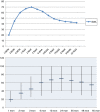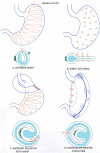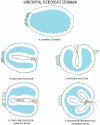Twelve year experience of laparoscopic gastric plication in morbid obesity: development of the technique and patient outcomes
- PMID: 22913751
- PMCID: PMC3444326
- DOI: 10.1186/1750-1164-6-7
Twelve year experience of laparoscopic gastric plication in morbid obesity: development of the technique and patient outcomes
Abstract
Background: Laparoscopic Gastric Plication (LGP) is a new restrictive bariatric surgery, previously introduced by the author. The aim of this study is to explain the modifications and to present the 12-year experience, regarding early and long term results, complications and cost.
Methods: We used LGP for morbid obesity during the past 12 years. Anterior plication (10 cases), one-row bilateral plication while right gastroepiploic artery included (42 cases), and excluded from the plication (104 cases) and two-row plication (644 cases). The gastric greater curvature was plicated using 2/0 prolen from fundus at the level of diaphragm preserving the His angle to just proximal to the pylorus. The anatomic and functional volume of stomach was 50cc and 25cc respectively in two-row method. Ordered postop visits also included evaluation of weight loss, complications, change of diet and control of exercise.
Results: LGP was performed in 800 cases (mean age: 27.5, range: 12 to 65 years, nine under 18). Female to male ratio was 81% to 19% and average BMI was 42.1 (35-59). The mean excess weight loss (EWL) was 70% (40% to 100%) after 24 months and 55% (28% to 100%) after 5 years following surgery. 134 cases (16.7%) did not completed long term follow-up. The average time of follow up was 5 years (1 month to 12 years). 5.5% and 31% of cases complained from weight regain respectively during 4 and 12 years after LGP. The mean time of operation was 72 (49-152) minutes and average hospitalization time was 72 hours (24 hours to 45 days). The cost of operation was 2000 $ less than gastric banding or sleeve and 2500 $ less than gastric bypass. Eight patients out of 800 cases (1%) required reoperation due to complications like: micro perforation, obstruction and vomiting following adhesion of His angle. Other complications included hepatitis pneumonia, self-limiting intra-abdominal bleeding and hypocalcaemia.
Conclusion: The percentage of EWL in this technique is comparable to other restrictive methods. The technique is safe with 1.6% complication (1% reoperated), and 31% regain during 12 years. The cost of operation is less than the other methods.
Figures












References
-
- Drewnowski A, Popkin BM. The nutrition transition: new trends in the global diet. Nutr Rev. 1997;55:31–43. - PubMed
-
- Popkin BM. The Nutrition Transition: An Overview of World Patterns of Change. Nutr Rev. 2004;62(7 Pt 2):S140–S143. - PubMed
-
- Popkin BM. The nutrition transition: an overview of world patterns of change. Nutr Rev. 2004;62:S140–S143. - PubMed
-
- Finucane MM, Stevens GA, Cowan MJ, Danaei G, Lin JK, Paciorek CJ, Singh GM, Gutierrez HR, Lu Y, Bahalim AN. National, regional, and global trends in body-mass index since 1980: systematic analysis of health examination surveys and epidemiological studies with 960 country-years and 9· 1 million participants. Lancet. 2011;12; 377(9765):557–67. - PMC - PubMed
LinkOut - more resources
Full Text Sources
Miscellaneous

